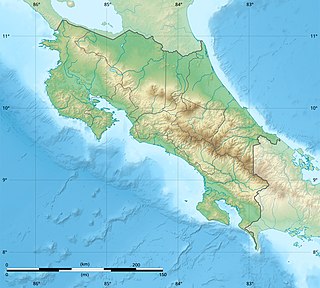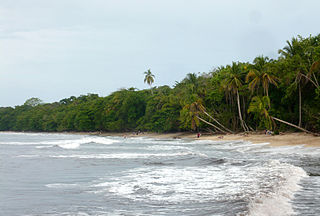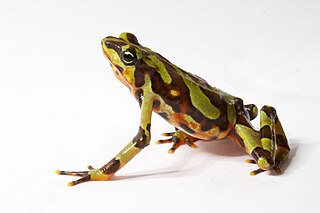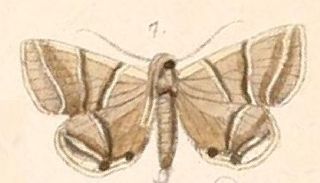
Costa Rica, officially the Republic of Costa Rica, is a country in the Central American region of North America, bordered by Nicaragua to the north, the Caribbean Sea to the northeast, Panama to the southeast, the Pacific Ocean to the southwest, and maritime border with Ecuador to the south of Cocos Island. It has a population of around five million in a land area of 51,060 km2 (19,710 sq mi). An estimated 333,980 people live in the capital and largest city, San José, with around two million people in the surrounding metropolitan area.

Costa Rica is located on the Central American Isthmus, surrounding the point 10° north of the equator and 84° west of the prime meridian. It has 212 km of Caribbean Sea coastline and 1,016 on the North Pacific Ocean.

Central America is a subregion of the Americas. Its boundaries are defined as bordering Mexico to the north, Colombia to the south, the Caribbean Sea to the east, and the Pacific Ocean to the west. Central America usually consists of seven countries: Belize, Costa Rica, El Salvador, Guatemala, Honduras, Nicaragua, and Panama. Within Central America is the Mesoamerican biodiversity hotspot, which extends from northern Guatemala to central Panama. Due to the presence of several active geologic faults and the Central America Volcanic Arc, there is a high amount of seismic activity in the region, such as volcanic eruptions and earthquakes which has resulted in death, injury, and property damage.

Cocos Island is an island in the Pacific Ocean administered by Costa Rica, approximately 550 km southwest of the Costa Rican mainland. It constitutes the 11th of the 13 districts of Puntarenas Canton of the Province of Puntarenas. With an area of approximately 23.85 km2 (9.21 sq mi), the island is more or less rectangular in shape. It is the southernmost point of geopolitical North America if non-continental islands are included.

Chusquea is a genus of evergreen bamboos in the grass family. Most of them are native to mountain habitats in Latin America, from Mexico to southern Chile and Argentina.

Monteverde is the twelfth canton of the Puntarenas province of Costa Rica. It is located in the Cordillera de Tilarán mountain range. Roughly a four-hour drive from the Central Valley, Monteverde is one of the country's major ecotourism destinations. The area is host to the Monteverde Cloud Forest Reserve and several other natural attractions, which draw considerable numbers of tourists and naturalists.

The wildlife of Costa Rica comprises all naturally occurring animals, fungi and plants that reside in this Central American country. Costa Rica supports an enormous variety of wildlife, due in large part to its geographic position between North and South America, its neotropical climate, and its wide variety of habitats. Costa Rica is home to more than 500,000 species, which represent nearly 5% of the species estimated worldwide, making Costa Rica one of the 20 countries with the highest biodiversity in the world. Of these 500,000 species, a little more than 300,000 are insects.

Cahuita National Park is a terrestrial and marine national park in the Caribbean La Amistad Conservation Area of Costa Rica located on the southern Caribbean coast in Limón Province, connected to the town of Cahuita. It protects beaches and lowlands and attracts tourists and other visitors who are able to snorkel in the protected marine area which contains the coralline reefs, as well as being a nesting ground for sea turtles. It covers a land area of 2,732 acres (1,106 ha), and a marine area of 55,200 acres (22,300 ha). February through April typically have the best underwater visibility. This is also one of the nicest and least developed beaches in Costa Rica.

Leptodeira is a genus of colubrid snakes commonly referred to as cat-eyed snakes. The genus consists of 18 species that are native to primarily Mexico and Central America, but range as far north as the Rio Grande Valley region of Texas in United States and as far south as Argentina in South America.

Calyptrogyne is a genus in the palm family (Arecaceae). The distribution of this genus is Central America, Colombia, and southern Mexico, with 11 of the 17 known species endemic to Panama. Calyptrogyne ghiesbreghtiana is the most widespread and best studied species in this genus.

Atelopus varius, the Costa Rican variable harlequin toad or clown frog, is a small Neotropical true toad from the family Bufonidae. Once ranging from Costa Rica to Panama, A. varius is now listed as critically endangered and has been reduced to a single remnant population near Quepos, Costa Rica and has only relict populations in western Panama (IUCN). Recent variation in air temperature, precipitation, stream flow patterns, and the subsequent spread of a pathogenic chytrid fungus (Batrachochytrium dendrobatidis) linked to global climate change have been the leading cause of decline for A. varius. A. zeteki has been considered a subspecies of A. varius, but is now generally considered a separate species.

Rejectaria is a genus of litter moths of the family Erebidae. The genus was erected by Achille Guenée in 1854.

Deforestation is a major threat to biodiversity and ecosystems in Costa Rica. The country has a rich biodiversity with some 12,000 species of plants, 1,239 species of butterflies, 838 species of birds, 440 species of reptiles and amphibians, and 232 species of mammals, which have been under threat from the effects of deforestation. Agricultural development, cattle ranching, and logging have caused major deforestation as more land is cleared for these activities. Despite government efforts to mitigate deforestation, it continues to cause harm to the environment of Costa Rica by impacting flooding, soil erosion, desertification, and loss of biodiversity.
Acaulospora is a genus of fungi in the family Acaulosporaceae. Species in this genus are widespread in distribution, and form arbuscular mycorrhiza and vesicles in roots.
The Costa Rica national under-20 football team represents Costa Rica in international football at this age level and is controlled by the Costa Rican Football Federation.
The Costa Rica national under-17 football team represents Costa Rica in international football at this age level and is controlled by the Federación Costarricense de Fútbol.
Cephaloleia splendida is a species of rolled-leaf beetle in the family Chrysomelidae, first found in Costa Rica and Panama.

Naatlo is a genus of ray spiders that was first described by Jonathan A. Coddington in 1986.

Adorea is a genus of leaf beetles in the subfamily Eumolpinae. It contains seven species, which are found in Central America and northern South America.














